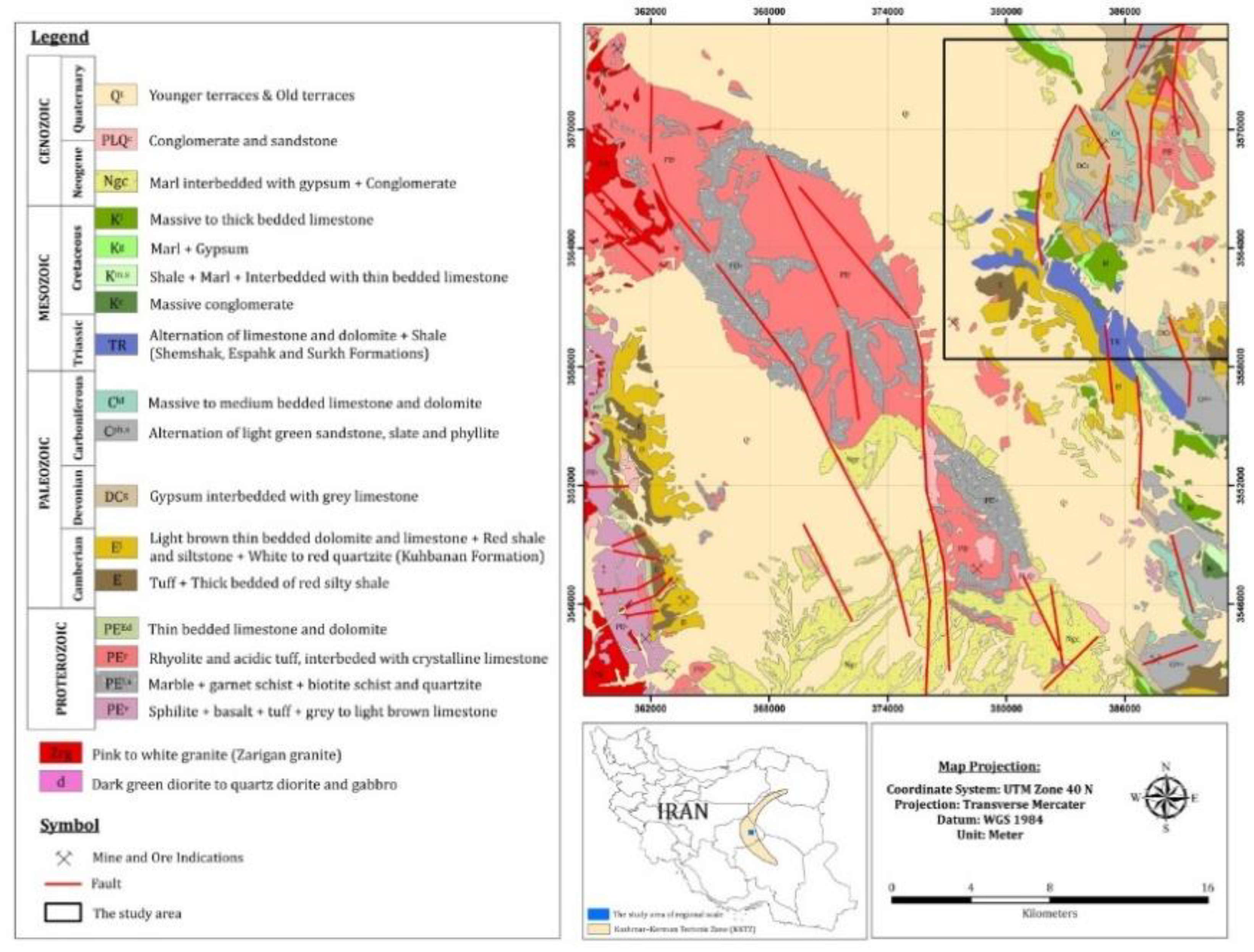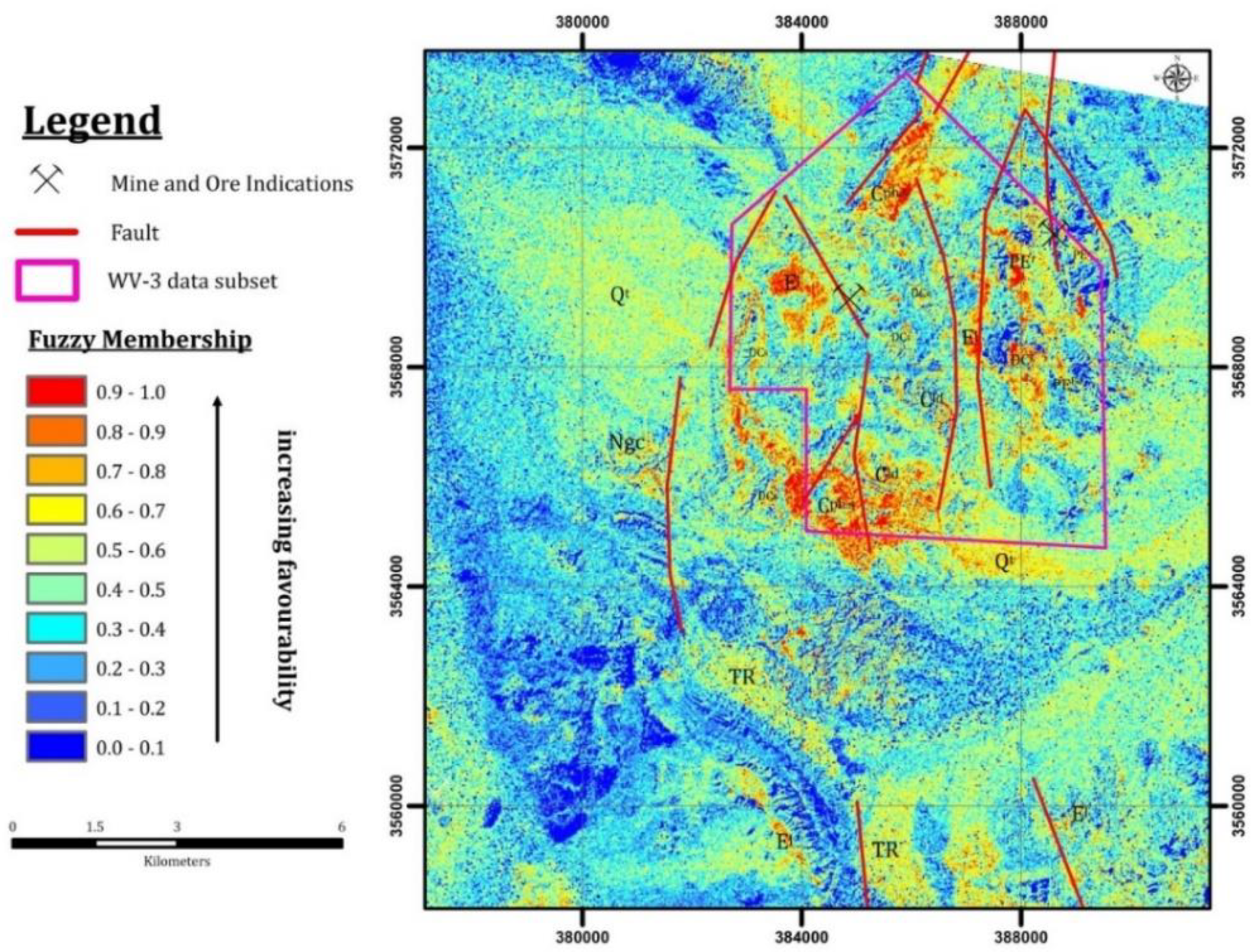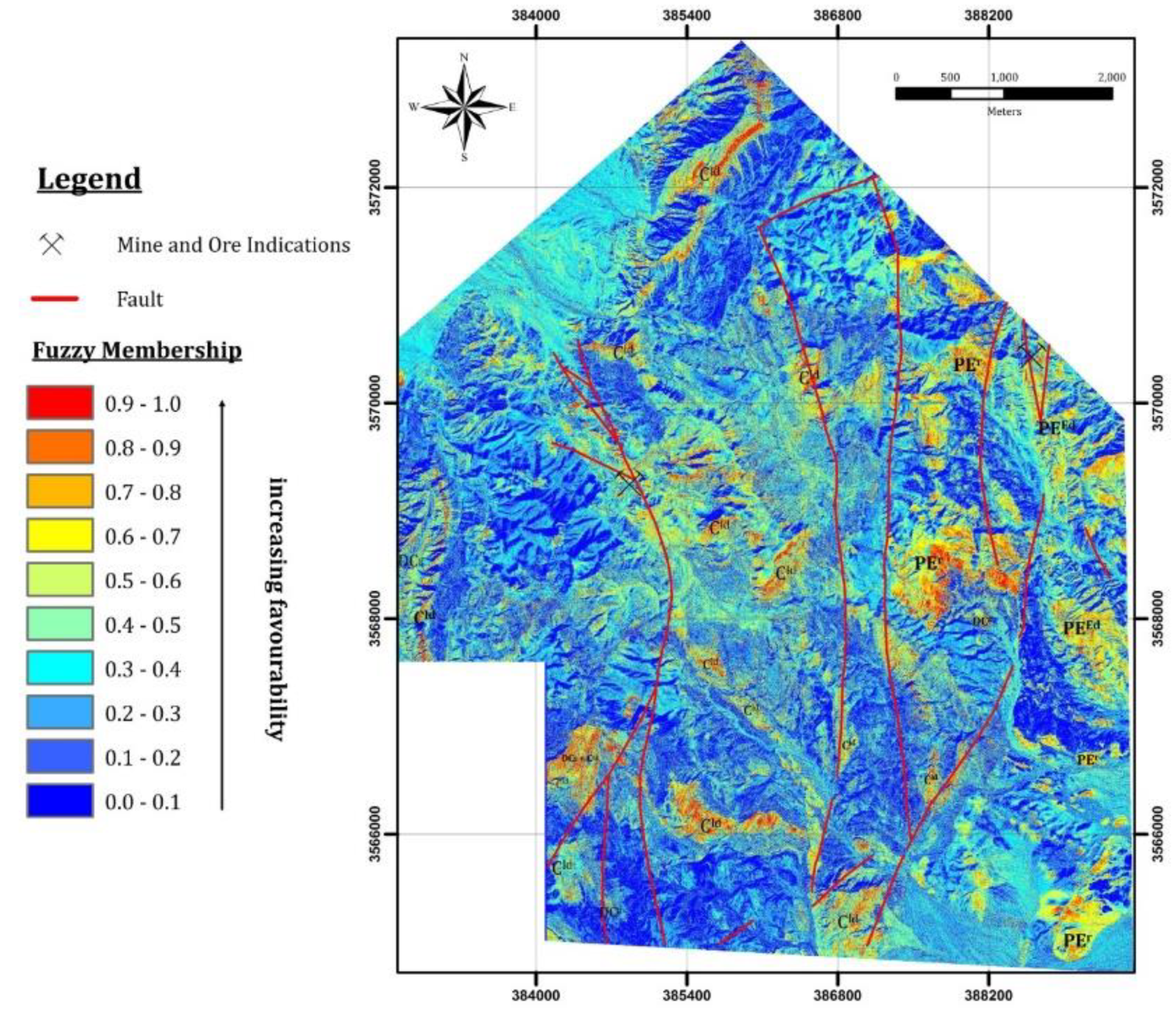Fuzzy Logic Modeling for Integrating the Thematic Layers Derived from Remote Sensing Imagery: A Mineral Exploration Technique †
Abstract
:1. Introduction
2. Geological Setting of the Study Area
3. Materials and Methods
3.1. Data Characteristics
3.2. Image Processing
3.2.1. Principal Components Analysis (PCA)
3.2.2. Fuzzy Logic Modeling
3.2.3. Fieldwork Data and Laboratory Analysis
4. Results and Discussion
5. Conclusions
Institutional Review Board Statement
Informed Consent Statement
Data Availability Statement
References
- Govil, H.; Gill, N.; Rajendran, S.; Santosh, M.; Kumar, S. Identification of new base metal mineralization in Kumaon Himalaya, India, using hyperspectral remote sensing and hydrothermal alteration. Ore Geol. Rev. 2018, 92, 271–283. [Google Scholar] [CrossRef]
- Pour, A.B.; Hashim, M.; Hong, J.K.; Park, Y. Lithological and alteration mineral mapping in poorly exposed lithologies using Landsat−8 and ASTER satellite data: North-eastern Graham Land, Antarctic Peninsula. Ore Geol. Rev. 2019, 108, 112–133. [Google Scholar] [CrossRef]
- Pour, A.B.; Park, Y.; Crispini, L.; Läufer, A.; Hong, J.K.; Park, T.-Y.S.; Zoheir, B.; Pradhan, B.; Muslim, A.M.; Hossain, M.S.; et al. Mapping Listvenite Occurrences in the Damage Zones of Northern Victoria Land, Antarctica Using ASTER Satellite Remote Sensing Data. Remote. Sens. 2019, 11, 1408. [Google Scholar] [CrossRef]
- Pour, A.B.; Park, T.-Y.S.; Hong, J.K.; Muslim, A.M.; Läufer, A.; Crispini, L.; Pradhan, B.; Zoheir, B.; Rahmani, O.; Hashim, M.; et al. Landsat−8, Advanced Spaceborne Thermal Emission and Reflection Radiometer, and WorldView−3 Multispectral Satellite Imagery for Prospecting Copper-Gold Mineralization in the Northeastern Inglefield Mobile Belt (IMB), Northwest Greenland. Remote. Sens. 2019, 11, 2430. [Google Scholar] [CrossRef]
- Pour, A.B.; Park, Y.; Park, T.-Y.S.; Hong, J.K.; Hashim, M.; Woo, J.; Ayoobi, I. Regional geology mapping using satellite-based remote sensing approach in Northern Victoria Land, Antarctica. Polar Sci. 2018, 16, 23–46. [Google Scholar] [CrossRef]
- Pour, A.B.; Hashim, M.; Park, Y.; Hong, J.K. Mapping alteration mineral zones and lithological units in Antarctic regions using spectral bands of ASTER remote sensing data. Geocarto Int. 2017, 33, 1281–1306. [Google Scholar] [CrossRef]
- Pour, A.B.; Park, T.-Y.S.; Park, Y.; Hong, J.K.; Zoheir, B.; Pradhan, B.; Ayoobi, I.; Hashim, M. Application of Multi-Sensor Satellite Data for Exploration of Zn–Pb Sulfide Mineralization in the Franklinian Basin, North Greenland. Remote. Sens. 2018, 10, 1186. [Google Scholar] [CrossRef]
- Kim, Y.-H.; Choe, K.-U.; Ri, R.-K. Application of fuzzy logic and geometric average: A Cu sulfide deposits potential mapping case study from Kapsan Basin, DPR Korea. Ore Geol. Rev. 2019, 107, 239–247. [Google Scholar] [CrossRef]
- Rajabi, A.; Rastad, E.; Canet, C. Metallogeny of Cretaceous carbonate-hosted Zn–Pb deposits of Iran: Geotectonic setting and data integration for future mineral exploration. Int. Geol. Rev. 2012, 54, 1649–1672. [Google Scholar] [CrossRef]
- Samani, B.A. Metallogeny of the Precambrian in Iran. Precambrian Res. 1988, 39, 85–106. [Google Scholar] [CrossRef]
- Abrams, M.; Tsu, H.; Hulley, G.; Iwao, K.; Pieri, D.; Cudahy, T.; Kargel, J. The Advanced Spaceborne Thermal Emission and Reflection Radiometer (ASTER) after fifteen years: Review of global products. Int. J. Appl. Earth Obs. Geoinform. 2015, 38, 292–301. [Google Scholar] [CrossRef]
- Kuester, M. Radiometric Use of WV−3 Imagery; Technical Note; DigitalGlobe: Westminster, CO, USA, 2016; p. 12. [Google Scholar]
- Gupta, R.P.; Tiwari, R.K.; Saini, V.; Srivastava, N. A simplified approach for interpreting principal component images. Adv. Remote Sens. 2013, 2, 111–119. [Google Scholar] [CrossRef]
- Zadeh, L.A. Fuzzy sets. Inform. Control 1965, 8, 338–353. [Google Scholar] [CrossRef]
- Novák, V.; Perfilieva, I.; Močkoř, J. Mathematical Principles of Fuzzy Logic; Kluwer Academic: Dordrecht, The Netherlands, 1999; ISBN 978-0-7923-8595-0. [Google Scholar]
- Mars, J.C.; Rowan, L.C. ASTER spectral analysis and lithologic mapping of the Khanneshin carbonate volcano, Afghanistan. Geosphere 2011, 7, 276–289. [Google Scholar] [CrossRef]
- Mars, J.C.; Rowan, L.C. Spectral assessment of new ASTER SWIR surface reflectance data products for spectroscopic mapping of rocks and minerals. Remote. Sens. Environ. 2010, 114, 2011–2025. [Google Scholar] [CrossRef]
- Hunt, G.R.; Ashley, R.P. Spectra of altered rocks in the visible and near infrared. Econ. Geol. 1979, 74, 1613–1629. [Google Scholar] [CrossRef]
- Clark, R.N. Spectroscopy of rock and minerals and principles of spectroscopy. In Remote Sensing for the Earth Sciences: Manual of Remote Sensing 3; Rencz, A.N., Ed.; John Wiley Sons: New York, NY, USA, 1999; pp. 3–58. [Google Scholar]



| (A) Eigenvector | Band 1 | Band 2 | Band 3 | Band 4 | Band 5 | Band 6 | Band 7 | Band 8 | Band 9 |
|---|---|---|---|---|---|---|---|---|---|
| PCA 1 | 0.306376 | 0.354156 | 0.357999 | 0.373947 | 0.327957 | 0.351186 | 0.312760 | 0.294817 | 0.311584 |
| PCA 2 | −0.506185 | −0.503027 | −0.377710 | 0.175856 | 0.271555 | 0.270302 | 0.240492 | 0.247816 | 0.226041 |
| PCA 3 | −0.277958 | −0.020633 | 0.232513 | 0.555288 | 0.118013 | 0.231883 | −0.218093 | −0.635404 | −0.202253 |
| PCA 4 | −0.123343 | −0.657125 | −0.626671 | 0.626671 | 0.219378 | 0.135436 | −0.037673 | −0.233067 | −0.106928 |
| PCA 5 | −0.005336 | −0.013068 | −0.049688 | 0.544534 | −0.082811 | −0.437342 | 0.180406 | 0.400661 | −0.556429 |
| PCA 6 | 0.269821 | −0.516554 | 0.233199 | 0.285564 | −0.309355 | −0.365753 | 0.067872 | −0.145724 | 0.518769 |
| PCA 7 | −0.209453 | 0.529334 | −0.464617 | 0.294560 | −0.485018 | −0.017691 | −0.005474 | −0.049871 | 0.367733 |
| PCA 8 | 0.027679 | −0.039707 | 0.000725 | 0.469109 | 0.336338 | −0.003040 | −0.870266 | 0.409042 | 0.160571 |
| PCA 9 | 0.152864 | −0.239013 | 0.098348 | 0.029191 | −0.632661 | 0.637281 | −0.028538 | 0.205046 | −0.244409 |
| (B) Eigenvector | Band 1 | Band 2 | Band 3 | Band 4 | Band 5 | Band 6 | Band 7 | Band 8 | |
| PCA 1 | −0.314986 | −0.330951 | −0.348156 | −0.359256 | −0.364601 | −0.367182 | −0.369097 | −0.370119 | |
| PCA 2 | 0.655926 | 0.454510 | 0.183457 | −0.046042 | −0.154854 | −0.251952 | −0.320189 | −0.370709 | |
| PCA 3 | −0.331273 | −0.598506 | 0.354295 | −0.129646 | 0.661001 | −0.220796 | 0.341420 | 0.108973 | |
| PCA 4 | −0.244961 | 0.345377 | 0.145561 | 0.631659 | 0.012267 | 0.368220 | −0.509311 | −0.142316 | |
| PCA 5 | −0.384633 | 0.279151 | 0.433976 | −0.092808 | 0.081588 | −0.370014 | −0.142544 | 0.187618 | |
| PCA 6 | 0.236442 | −0.427799 | −0.515988 | −0.065670 | 0.646312 | 0.248715 | 0.043257 | 0.095274 | |
| PCA 7 | 0.257771 | −0.301701 | −0.070317 | −0.389055 | 0.471694 | 0.225588 | −0.427691 | 0.035215 | |
| PCA 8 | 0.174655 | −0.560947 | 0.307690 | −0.163685 | −0.332755 | 0.108819 | 0.068151 | −0.001993 | |
| Data Origin | Input Layer | Detection | Membership Type | Fuzzy Operator |
|---|---|---|---|---|
| ASTER Dataset | PC4 | Iron oxide/hydroxide minerals | Linear | Gamma (γ = 0.6) |
| PC5 | OH/S-O/CO3-bearing minerals | |||
| PC8 | Dolomite | |||
| WorldView-3 Dataset | PC3 | All iron oxides | Linear | AND |
| PC4 | Dolomite/Fe2+ oxides | |||
| PC6 | Fe3+ oxides |
Publisher’s Note: MDPI stays neutral with regard to jurisdictional claims in published maps and institutional affiliations. |
© 2021 by the authors. Licensee MDPI, Basel, Switzerland. This article is an open access article distributed under the terms and conditions of the Creative Commons Attribution (CC BY) license (https://creativecommons.org/licenses/by/4.0/).
Share and Cite
Sekandari, M.; Beiranvand Pour, A. Fuzzy Logic Modeling for Integrating the Thematic Layers Derived from Remote Sensing Imagery: A Mineral Exploration Technique. Environ. Sci. Proc. 2021, 6, 8. https://doi.org/10.3390/iecms2021-09349
Sekandari M, Beiranvand Pour A. Fuzzy Logic Modeling for Integrating the Thematic Layers Derived from Remote Sensing Imagery: A Mineral Exploration Technique. Environmental Sciences Proceedings. 2021; 6(1):8. https://doi.org/10.3390/iecms2021-09349
Chicago/Turabian StyleSekandari, Milad, and Amin Beiranvand Pour. 2021. "Fuzzy Logic Modeling for Integrating the Thematic Layers Derived from Remote Sensing Imagery: A Mineral Exploration Technique" Environmental Sciences Proceedings 6, no. 1: 8. https://doi.org/10.3390/iecms2021-09349







